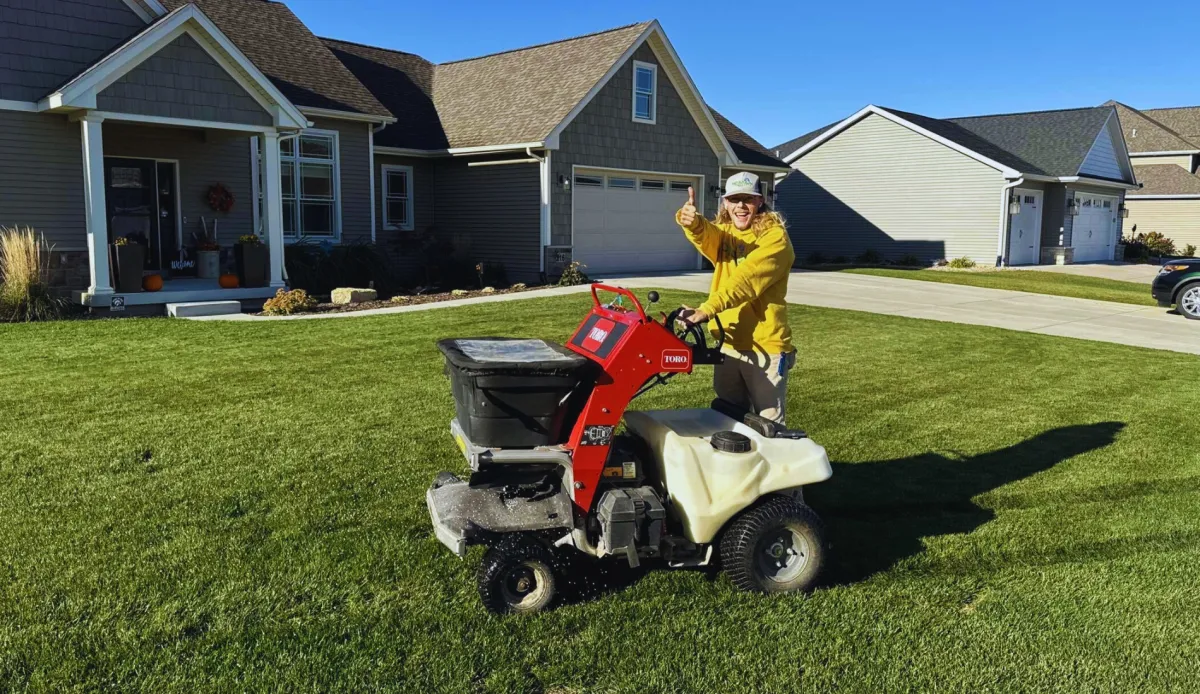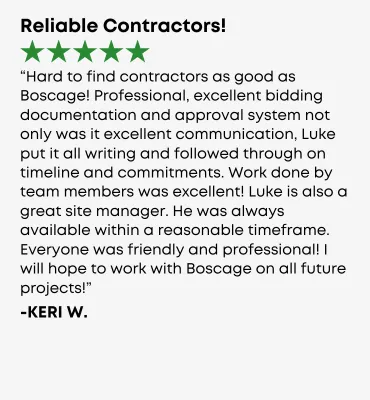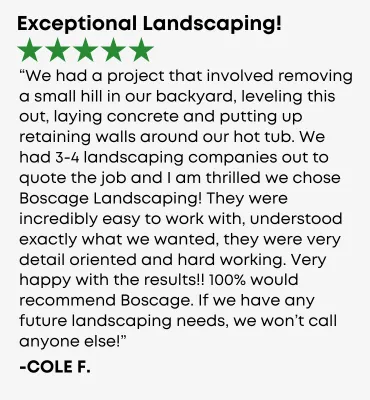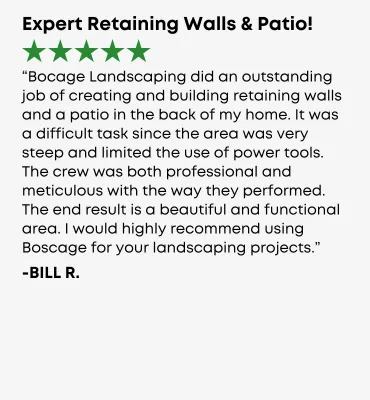
How to Keep Your Bettendorf Mulch Beds Looking Amazing!
Spring is in full swing here in the Quad Cities, and it's time to get those mulch beds in shape! As a Bettendorf landscaping professional with over 11 years of experience transforming local properties, I wanted to share some expert tips on how to keep your mulch beds looking their absolute best throughout our Iowa seasons.
Check out the Lawn Whisperers channel for more great Midwest lawn advice. While the video offers solid general advice, I'll add some local expertise to help you achieve those picture-perfect mulch beds.
Step 1: Create Clean, Defined Edges for Your Mulch Beds
The foundation of a beautiful mulch bed starts with crisp, clean edges. Here in Bettendorf, our clay-heavy soil can make this challenging, but it's worth the effort. At Boscage Landscaping, our 10-person team uses specialized edging tools to create perfect borders that not only look professional but also serve an important purpose.
Clean edges help prevent grass from encroaching into your flower beds and make mowing around them much easier. Many of our 500+ active clients tell us that well-defined edges are what make their landscaping stand out from their neighbors'.
Bettendorf Tip: Our local soil tends to shift more than average during our freeze-thaw cycles. We recommend edging your beds slightly deeper (about 4-5 inches) than what's standard in other regions to maintain those crisp lines throughout our variable Midwest seasons.
Step 2: Thorough Weed Removal - The Boscage Method
Removing weeds is critical before refreshing your mulch beds. Our unique approach at Boscage involves a complete clearing of the bed rather than just surface removal. This is because many of our local Quad Cities weeds have deep root systems that will quickly regrow if not fully addressed.
During this process, we carefully identify and preserve desirable plants. One thing I've noticed in Bettendorf gardens specifically is that many homeowners don't realize they have valuable perennials mixed in with what appears to be an overgrown bed. Our team is trained to recognize local perennials that might be dormant or just emerging in early spring.
Pro Tip: If you find good sections of grass during your weed removal, don't waste them! Similar to the video creator's approach with the Pro Plugger, we often transplant healthy grass patches to areas that need filling in. This sustainable practice is part of our commitment to environmentally responsible landscaping.
Step 3: Apply Quality Pre-Emergent - With a Bettendorf Twist
Pre-emergent herbicides create a barrier that prevents weed seeds from germinating, keeping your mulch beds looking pristine for months. But there's a specific approach needed for our local conditions.
At Boscage Landscaping, we've found that timing pre-emergent application is even more critical here than in other regions.
Local Insight: The optimal application window for pre-emergent in our area is typically early to mid-April, slightly earlier than many national guidelines suggest. This is because our proximity to the river creates a microclimate that can accelerate weed growth by 1-2 weeks compared to just 20 miles inland.
Remember to adjust your coverage based on your specific soil type. In the many neighborhoods of Bettendorf, soil can vary dramatically - from sandy compositions near the river to dense clay in newer developments. For our typical local soil, aim for coverage of about 800-900 square feet per application, a middle ground between the sandy and clay recommendations mentioned in the video.
Selecting the Right Plants for Bettendorf Mulch Beds
Choosing the right plants can make a huge difference in the long-term beauty of your mulch beds. While the video shows a nice arrangement, I want to recommend some options that thrive specifically in our Bettendorf climate.
From my 11 years of experience working with over 500 local properties, I've found these plants to be particularly successful in our Eastern Iowa soil and climate conditions:
Coneflowers - Native to our region and able to withstand our hot summer days
Hardy Geraniums - They provide beautiful color and handle our clay soil well
Black-eyed Susans - These provide vibrant color from July through October
Hostas - Perfect for those shady areas under trees in Bettendorf yards
When arranging your plants, consider their mature size and the specific light conditions of your property. Many Bettendorf homes, especially in established neighborhoods like Duck Creek or Pleasant Valley, have mature trees that create varied light patterns throughout the day.
The Mulch Question: Which Type is Best for Bettendorf Gardens?
The video creator chose black mulch, which certainly provides dramatic contrast. In my extensive experience with Bettendorf properties, I've found that mulch selection should be based on more than just aesthetics.
Here in Eastern Iowa, we need to consider:
Cedar mulch - Our most popular option because it naturally repels many local insects
Hardwood mulch - Breaks down gradually, improving our often dense soil over time
Black mulch - Creates beautiful contrast but retains more heat (which can be beneficial for some plant varieties in our sometimes cooler springs)
At Boscage Landscaping, we recommend hardwood mulch for most Bettendorf properties, as it provides the best balance of appearance, functionality, and value. We source our mulch locally, ensuring it's free from contaminants and invasive seeds that can cause problems down the road.
Local Tip: Apply 2-3 inches of mulch in your beds. Any less won't provide adequate weed suppression; any more can suffocate plant roots, especially in our heavier soil.
Maintaining Mulch Beds Throughout the Bettendorf Seasons
The real secret to stunning mulch beds isn't just in the installation—it's in the maintenance. With our distinct seasonal changes in the Quad Cities, your maintenance routine needs to adapt throughout the year.
Here's my Bettendorf-specific maintenance calendar:
Spring (April-May):
Edge beds and apply fresh mulch
Apply pre-emergent herbicide
Begin regular watering as temperatures rise
Summer (June-August):
Spot-treat any weeds that emerge
Ensure adequate watering during our hot, sometimes dry periods
Trim back any overgrown plants
Fall (September-November):
Remove fallen leaves from beds (they can mat down and cause mold issues in our humid climate)
Cut back perennials as they die back
Consider a light mulch refresh if needed
Winter (December-March):
Minimize foot traffic on frozen beds to prevent soil compaction
Plan your spring refresh while dreaming of warmer days!
Why Professional Help Makes a Difference
While DIY landscaping can be rewarding, there's a reason why over 500 Bettendorf homeowners trust Boscage Landscaping with their property. Our 10-person team brings over 25 years of combined experience specifically in Eastern Iowa conditions.
We understand the unique challenges of Bettendorf soil, the specific weed varieties that plague our region, and the plant selections that will thrive in your particular yard. Plus, our bulk purchasing power means we can often provide premium materials at competitive prices.
Whether you need a complete mulch bed overhaul or just some professional guidance, our team is here to help. Remember, beautiful landscaping isn't just about curb appeal—it's about creating outdoor spaces that enhance your daily life.
Ready to transform your mulch beds? Contact Boscage Landscaping at (563) 209-4636 or visit www.boscagelandscaping.com to schedule your free consultation. Serving Bettendorf, LeClaire, and surrounding Quad Cities areas since 2014.






